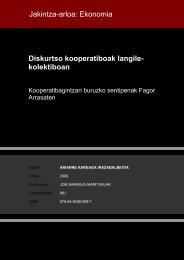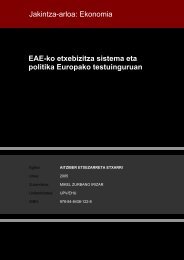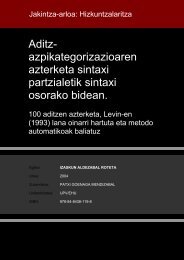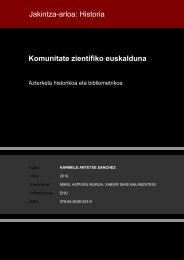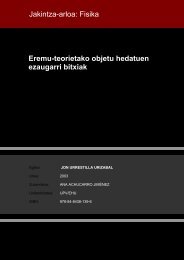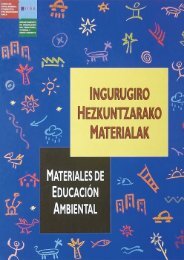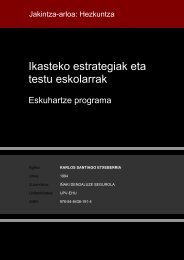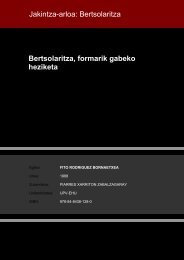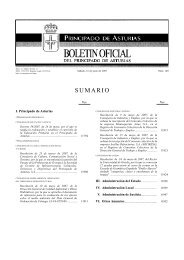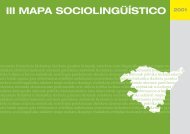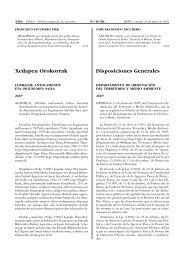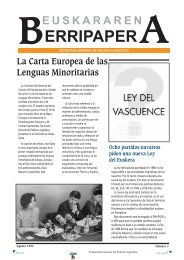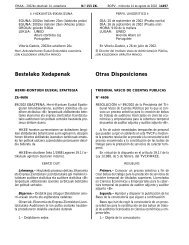- Page 1 and 2:
Jakintza-arloa: Pedagogia Ikasle he
- Page 3 and 4:
ikasteko motibazioa, euskara-ikasle
- Page 10:
Esker onak Ezer baino lehen, eskert
- Page 13 and 14:
10 2.5. Ikas-estrategiak...........
- Page 15 and 16:
12 4. AZTERKETA ENPIRIKOA..........
- Page 17 and 18:
14 Taulen Aurkibidea 1.1. taula: er
- Page 19 and 20:
16 Grafikoen Aurkibidea 1.1. grafik
- Page 21 and 22:
18 • Ikertzailea, hizkuntza-iraka
- Page 23 and 24:
20 1.3. Ikerketaren antolaketa Iker
- Page 25 and 26:
22 H1 = euskara eta erdara H1 = erd
- Page 27 and 28:
24 1.6. Helduen euskalduntzea gaur
- Page 29 and 30:
26 1.6.2. Euskaltegiak Gaur egun 14
- Page 31 and 32:
28 1.3. grafikoa: ikasleak euskaldu
- Page 33 and 34:
30 1.5. grafikoa: 97/98 ikasturteko
- Page 36 and 37:
2.1. Zer da ikaskuntza? 2.1.1. Ikas
- Page 38 and 39:
Sariak eta errefortzuak dira ikasku
- Page 40 and 41:
Vytgotski Ausubel Teoria bat baino
- Page 42 and 43:
2.1.2.5. Humanismoa Rogers-ek (1975
- Page 44 and 45:
2.1.2.9. Laburpen modura Ikaskuntza
- Page 46 and 47:
• Eskuratzeko helburuak zehazten
- Page 48 and 49:
2.1.6. Hizkuntza-ikaskuntzaren proz
- Page 50 and 51:
2.2.2. Gardner-en eredua Gardner-en
- Page 52 and 53:
2.2.4. Giles eta Byrne-ren eredua G
- Page 54 and 55:
Ikaslearen berezitasunak: gizaki ba
- Page 56 and 57:
2.3. H2ren ikasle onaren jokaera 2.
- Page 58 and 59:
2. Ikasle onaren desioa komunikatze
- Page 60 and 61:
2.3.4. H2ren ikasle onaren jokabide
- Page 62 and 63:
2.4.2. Ikas-estiloen definizioak Ik
- Page 64 and 65:
Alonso, Gallego eta Honey-k (1994)
- Page 66 and 67:
Hona hemen ikas-estiloen sailkapen
- Page 68 and 69:
Test neurgailuari erantzuteko batzu
- Page 70 and 71:
2.5.2.2. Kontzeptuen bereizketa Lit
- Page 72 and 73:
Oxford-entzat garrantzitsua da jaki
- Page 74 and 75:
1. Gogoan hartzeko estrategiak Oroi
- Page 76 and 77:
Estrategia sozio-afektiboak Estrate
- Page 78 and 79:
I. Estrategia mnenonikoak II. Estra
- Page 80 and 81:
Oxford-en sailkapen honek zenbait k
- Page 82 and 83:
9. Itzultzea (translation) eta H1ek
- Page 84 and 85:
2.5.4. Ikas-estrategiak aukeratzera
- Page 86 and 87:
• Ikasle asiarrek estrategia mnem
- Page 88 and 89:
2.5.4.5. Faktore pertsonalak 1. Nor
- Page 90 and 91:
2.5.5. Ikas-estrategien irakaskuntz
- Page 92 and 93:
Weaver eta Cohen-ek (1997) honako 7
- Page 94 and 95:
Testuliburuen txertatutako estrateg
- Page 96 and 97:
2.5.5.6. Ikas-estrategien irakaskun
- Page 98 and 99:
• H2ren ikaskuntzaren inguruko ja
- Page 100 and 101:
Azurmendi-k (1996) akulturazio inte
- Page 102 and 103:
2.6.3. H2ren erabileraren ebaluazio
- Page 104 and 105:
2.6.4. Euskararen erabileraren azte
- Page 106 and 107:
horietan %69k eta %74k kide guztiak
- Page 108 and 109:
Zenbat eta zaharrago, orduan eta er
- Page 110 and 111:
2.1. grafikoa: Euskararen erabilera
- Page 112 and 113:
3. ESKU-HARTZE PROGRAMA BATEN PROPO
- Page 114 and 115:
Bestalde, Wenden-ek (1991) ikas-est
- Page 116 and 117:
3.2. Bereziki landu nahi diren atal
- Page 118 and 119:
115 Gertatzen zaigun edozer gauza,
- Page 120 and 121:
117 Kultura desberdineko ikasleak,
- Page 122 and 123:
119 Bigarren hizkuntza baten ikasle
- Page 124 and 125:
3.3.2. Programa pilotua Esku-hartze
- Page 126 and 127:
3.3.2.4. Esku-hartzearen eremua 123
- Page 128 and 129:
• Ikas-estiloa epe motzean aldatu
- Page 130 and 131:
• Irakasleak egokitu egin behar a
- Page 132 and 133:
3.4. Behin betiko esku-hartze progr
- Page 134 and 135:
3.4.2. Esku-hartze programaren hist
- Page 136 and 137:
III.3. Ikas-estiloez argibideak. 13
- Page 138 and 139:
IV. urratsa: Esku-hartze pedagogiko
- Page 140 and 141:
3.4.4. Ikertzailearen eta irakaslee
- Page 142 and 143:
Zuzendaritza 3.6. irudia: esku-hart
- Page 144 and 145:
II.4. Euskaltegiko ikasleekin lehen
- Page 146 and 147:
e) Metodologia gardenagoa erabili 1
- Page 148 and 149:
III.3. Ikas-estiloez argibideak eta
- Page 150 and 151:
Ikas-estiloen hobekuntza 147 Diagno
- Page 152 and 153:
Ikas-estilo teorikoa hobetzeko irad
- Page 154 and 155:
151 irakasleengan ezagutu, aztertu
- Page 156 and 157:
IV.3.Esku-hartze pedagogikoaren eba
- Page 158 and 159:
3.4.6.3. Prestaketa 155 1. Lehenik,
- Page 160 and 161:
Zeharkako ikas-estrategiak D: metak
- Page 162 and 163:
Ikas-estiloa aktiboa erreflexiboa N
- Page 164 and 165:
3.4.6.6. Ariketa-ereduen banaketa 1
- Page 166 and 167:
3.4.6.7. Unitate didaktikoen laburp
- Page 168 and 169:
3. ASTEKO UNITATEAK 9. unitatea: Ik
- Page 170 and 171:
5. ASTEKO UNITATEAK 17. unitatea: I
- Page 172 and 173:
7. ASTEKO UNITATEAK 25. unitatea: I
- Page 174 and 175:
Aldaerak: 171 Ibiltzen hasi aurreti
- Page 176 and 177:
Egin nahi duzuna: Diskoak entzun Su
- Page 178 and 179:
175
- Page 180 and 181:
177 Mahai baten inguruan eseriko di
- Page 182 and 183:
Ak.7 Animatu baikor izatera Lantzek
- Page 184 and 185:
Oharrak: 181 Ikasleentzat oso arike
- Page 186 and 187:
183 Ikasleentzako azalpena: Komunik
- Page 188 and 189:
Ak.14 Lotsa Lantzeko Ikas-estiloa:
- Page 190 and 191:
Ak.18 Animatu arriskatzera Lantzeko
- Page 192 and 193:
Ak.20 Komunikazioa baztertu partzia
- Page 194 and 195:
3.4.6.8.2. Ikas-estilo erreflexiboa
- Page 196 and 197:
193 2. Jardueraren bukaeran, ikasle
- Page 198 and 199:
Eskolan zehar: 195 • Idatzi 3 ler
- Page 200 and 201:
Oharrak: - 197 Iturburua: • Oxfor
- Page 202 and 203:
199 • Hirunaka jarri eta elkarri
- Page 204 and 205:
201 Ikasleentzako azalpena Zure leh
- Page 206 and 207:
Adibideak: Ramon-ek, ostiralero ber
- Page 208 and 209:
3.4.6.8.3. Ikas-estilo teorikoa lan
- Page 210 and 211:
207 azaldu eta arrazoitu. Planoak p
- Page 212 and 213:
Eskola aurretik: - 209 Eskolan zeha
- Page 214 and 215:
211 eginez eta animatuz beren produ
- Page 216 and 217:
Adibideak: - Eskola aurretik: - 213
- Page 218 and 219:
215 Ikasleentzako azalpena Saiatu e
- Page 220 and 221:
3.4.6.8.4. Ikas-estilo pragmatikoa
- Page 222 and 223:
219 buruz errepikatu egingo dio atz
- Page 224 and 225:
Antolaketa: Bakarkako lana Material
- Page 226 and 227:
223 • Koldo bere lankide euskaldu
- Page 228 and 229:
225 • Raquel-ek zinema sarritan e
- Page 230 and 231:
Prag.12 500 pta. Lantzeko Ikas-esti
- Page 232 and 233:
Aldaerak: - Oharrak: - 229 Iturburu
- Page 234 and 235:
Prag.18 agiria Lantzeko Ikas-estilo
- Page 236 and 237:
4.1. Planteamendua 4.1.1. Helburu e
- Page 238 and 239:
3. Hipotesia 235 Wenden-ek (1991) d
- Page 240 and 241:
237 Aldagai parte-hartzaileak jaiot
- Page 242 and 243:
4.2.2.2. Mendeko aldagaiak 239 Oper
- Page 244 and 245:
Euskara ikasteko autoestimaren inte
- Page 246 and 247:
Ikas-estiloak neurtzeko proba 243 I
- Page 248 and 249:
Hizkuntzen ezagutza, ikaskuntzan iz
- Page 250 and 251:
• Jaioterri beretsuko subjektuak
- Page 252 and 253:
4.2.6. Landa-lanak izandako baldint
- Page 254 and 255:
4.3. Analisi estatistikoak 251 Hasi
- Page 256 and 257:
4.4.1.1.3. Talde osoko aldagai nagu
- Page 258 and 259:
4.5. grafikoa: laginaren ikas-estil
- Page 260 and 261:
4.4.2. Hipotesiei buruzko emaitzak
- Page 262 and 263:
259 4.10. taulan ikusten dugu laner
- Page 264 and 265:
portzentajeak % 4. Hipotesia: 4.9.
- Page 266 and 267:
4.16. taula: Mendeko aldagaia: IKAS
- Page 268 and 269: 6. Hipotesia: 265 Ikas-estiloetan e
- Page 270 and 271: 4.19. eta 4.21. tauletako datuak gr
- Page 272 and 273: Testaurrea: 269 Lehenik, ikas-estra
- Page 274 and 275: Ondoren ikusten ditugu dauden emait
- Page 276 and 277: Aldaketa: 273 Ikusteko nolabaiteko
- Page 278 and 279: 4.4.3. Bestelako emaitzak 4.4.3.1.
- Page 280 and 281: 4.29. taula: egoeren araberako erab
- Page 282 and 283: 4.23. grafikoa: mintzakide berrien
- Page 284 and 285: Esperimentutaldea % Kontroltaldea %
- Page 286 and 287: 4.27. grafikoa: euskararen erabiler
- Page 288 and 289: 3. Esperientzia honetatik zer izan
- Page 290 and 291: 4.4.3.2.2. Irakasleen balorazioa Ir
- Page 292 and 293: 4.4.3.2.4. Euskaltegiko klaustro-ki
- Page 294 and 295: 5. EMAITZEN EZTABAIDA ETA ONDORIO O
- Page 296 and 297: 4. Ikas-estrategien ikaskuntza eta
- Page 298 and 299: 6. Landutako ikas-estrategien artea
- Page 300 and 301: 10. Mintzakide berrien sortze-egoer
- Page 302 and 303: 5.2. Ondorio orokorrak 299 1. Oro h
- Page 304 and 305: 5.3. Ikerketaren mugak eta ikerkunt
- Page 306 and 307: 5.3.2. Inplikazio psikopedagogikoak
- Page 308 and 309: 305 9. Esku-hartze plan honetan, ha
- Page 310 and 311: 3. Non ikertu 307 Ikerketa honetan
- Page 312 and 313: 8. Norentzat ikertu 309 Bukatzeko,
- Page 314 and 315: 6.BIBLIOGRAFIA Abraham, R. (1985).
- Page 316 and 317: 313 Ballinger, R. eta Ballinger, V.
- Page 320 and 321: (Technical Report 13). Honolulu: Se
- Page 322 and 323: Danserau, D. (1985). “Learning st
- Page 324 and 325: Ericsson, K. eta Simon, H. (1993).
- Page 326 and 327: 323 Gardner, R.,Tremblay, R. eta Ma
- Page 328 and 329: Holec, H. (1997). “Preface” in
- Page 330 and 331: Kemper, R. eta Vernooy, R. (1993).
- Page 332 and 333: 329 Lochart, D. eta Schmeck, R.R. (
- Page 334 and 335: 331 Naiman, N., Frohlich, M., Stern
- Page 336 and 337: Oxford, R. etaCrookall (1989). “R
- Page 338 and 339: 335 Ramsey, R.M.G. (1980). “Langu
- Page 340 and 341: 337 Ryan, E., Giles, H. eta Sebasti
- Page 342 and 343: Sobrado, L. (1990). Intervención P
- Page 344 and 345: Txillardegi eta Isasi, X. (1994). S
- Page 346 and 347: Wenden, A. eta Rubin, J. (1987). Le
- Page 348 and 349: 7.1. Erabilitako neurgailuak 7.1.1.
- Page 350 and 351: 7.1.2. Motibazioaren intentsitatera
- Page 352 and 353: 7.1.3. Autoestimarako proba 7.1.3.1
- Page 354 and 355: 7.1.4. Ikas-estiloak: CHAEA (gaztel
- Page 356 and 357: 353 ... 55. Prefiero discutir cuest
- Page 358 and 359: pragmático Gráfica: Estilos de Ap
- Page 360 and 361: 357 ... 24. Gustukoago dauzkat pert
- Page 362 and 363: Oharrak: Ikaskuntza-profila 1. Boro
- Page 364 and 365: 7.1.6. Euskararen erabilera-soziala
- Page 366 and 367: 363 3. Erabiltzen al duzu euskara o
- Page 368 and 369:
2. Azken 5 hilabeteetan, hitz egin
- Page 370 and 371:
1= casi nunca 2 = pocas veces 3 = v
- Page 372 and 373:
Ikasleen elkarrizketarako galderak



